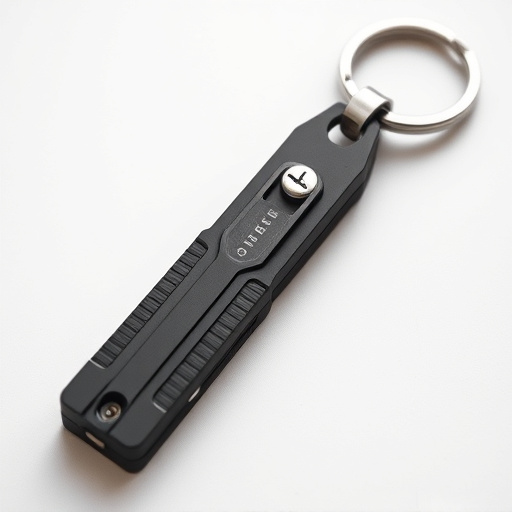Selecting the best alloys for defense keychains is vital, favoring corrosion-resistant stainless steel (304, 316 grade) or lightweight alternatives like titanium and aluminum. High-end steels offer exceptional hardness, edge retention, and impact absorption. Safe designs with locking features ensure reliability. Responsible ownership includes legal knowledge and adherence to regulations.
In today’s world, personal safety is paramount. Portable keychain weapons offer a discreet yet potent means of self-defense. This article delves into the critical aspects of designing effective defense keychains, focusing on the best alloys for durability and corrosion resistance, strategic blade design, and essential safety mechanisms like locking and disarm features. We also explore legal implications and responsible ownership practices for these compact tools.
- Choosing Alloys for Durability and Corrosion Resistance
- Cutting Edges: Effective Blade Design Considerations
- Safety Mechanisms: Locking and Disarm Features
- Legal Implications and Responsible Ownership
Choosing Alloys for Durability and Corrosion Resistance
When crafting defense keychains designed for portability and functionality, selecting the right alloys is paramount for ensuring durability and longevity in various environments. The best alloys for defense keychain applications offer superior corrosion resistance to withstand exposure to moisture, salt water, and other corrosive substances often found outdoors or in challenging conditions. Stainless steel, specifically 304 and 316 grades, tops the list due to its exceptional corrosion resistance and strength-to-weight ratio. These grades contain high chromium levels, creating an inert surface that impedes rust formation, making them ideal for harsh conditions.
Additionally, alloys like titanium and aluminum offer lightweight alternatives without compromising durability. Titanium is renowned for its strength, low density, and excellent corrosion resistance, making it a top choice for military and tactical applications. Aluminum, while not as robust as titanium, provides good value in terms of affordability and light weight, offering reasonable protection against corrosion when coated properly. Choosing the best alloys for defense keychains involves evaluating specific needs, environmental factors, and cost considerations to ensure optimal performance and reliability over time.
Cutting Edges: Effective Blade Design Considerations
When designing cutting edges for defense keychain weapons, the choice of alloys plays a crucial role in ensuring both effectiveness and portability. The best alloys for defense keychains should offer excellent edge sharpness, durability, and corrosion resistance. High-quality stainless steels, such as 440C or N690 Co, are popular choices due to their superior hardness (typically above 57 RC) and ability to retain an edge. These alloys also resist rust and corrosion, vital features for a compact self-defense tool that may be exposed to various environments.
Additionally, the design should consider the balance between blade strength and flexibility. A robust yet somewhat flexible keychain blade can better absorb impact during use, reducing the risk of breakage. This is especially important in a portable form factor where replacing or repairing the weapon may not always be convenient. The right alloy combination and thoughtful blade geometry can create an efficient cutting edge that serves as a reliable defense mechanism without compromising the device’s compactness.
Safety Mechanisms: Locking and Disarm Features
When it comes to choosing a portable keychain weapon, safety mechanisms like locking and disarm features are paramount. These features ensure that the device is secure when not in use, preventing accidental activation and ensuring only intended users can access it. High-quality defense keychains often incorporate robust locking systems that require a specific action or code to open, adding an extra layer of protection.
The best alloys for defense keychains play a crucial role in these safety features. Alloys like stainless steel and titanium are favored for their strength, durability, and resistance to corrosion. These materials guarantee the longevity and reliability of locking mechanisms, ensuring they function flawlessly over time. Additionally, some advanced models feature disarm mechanisms that require a specific sequence or motion to render the keychain inert, providing users with complete control and peace of mind.
Legal Implications and Responsible Ownership
When carrying a keychain weapon, it’s crucial to understand the legal implications and responsibilities that come with ownership. The use, possession, and carriage of self-defense tools are subject to stringent laws varying across jurisdictions. Owning a defense keychain is not just about personal safety; it involves adhering to local regulations designed to maintain public safety and prevent misuse.
Choosing the best alloys for defense keychains is essential for both effectiveness and legality. High-quality materials ensure the weapon’s durability, reliability, and functionality. However, these choices should align with legal standards to avoid legal complications. Responsible ownership includes familiarizing oneself with local laws, storing the device securely, and only using it in situations where self-defense is justified under the law.
When considering a portable keychain weapon, selecting the right alloy is paramount for both durability and corrosion resistance. Incorporating effective blade design with cutting edges optimized for versatility and safety mechanisms like locking and disarm features, ensures a secure yet practical self-defense tool. Remember, responsible ownership includes understanding legal implications, adhering to regulations, and prioritizing safe storage and use. Opting for the best alloys in defense keychain designs allows individuals to protect themselves effectively while navigating legal responsibilities.
